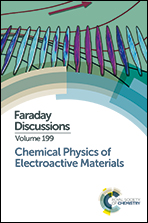Electrochemical plasmonic metamaterials: towards fast electro-tuneable reflecting nanoshutters
Abstract
Self-assembling arrays of metallic nanoparticles at liquid|liquid or liquid|solid interfaces could deliver new platforms for tuneable optical systems. Such systems can switch between very-high and very-low reflectance states upon assembly and disassembly of nanoparticles at the interface, respectively. This encourages creation of electro-variably reversible mirror/window nanoplasmonic devices. However, the response time of these systems is usually limited by the rate-of-diffusion of the nanoparticles in the liquid, towards the interface and back. A large time-constant implies slow switching of the system, challenging the practical viability of such a system. Here we introduce a smart alternative to overcome this issue. We propose obtaining fast switching via electrically-induced rotation of a two-dimensional array of metal nanocuboids tethered to an ITO substrate. By applying potential to the ITO electrode the orientation of nanocuboids can be altered, which results in conversion of a highly-reflective nanoparticle layer into a transparent layer (or vice versa) within sub-second timescales. A theoretical method is developed based on the quasi-static effective-medium approach to analyse the optical response of such arrays, which is verified against full-wave simulations. Further theoretical analysis and estimates based on the potential energy of the nanoparticles in the two orientations corroborate the idea that voltage-controlled switching between the two states of a nanoparticle assembly is a viable option.
- This article is part of the themed collection: Chemical Physics of Electroactive Materials

 Please wait while we load your content...
Please wait while we load your content...